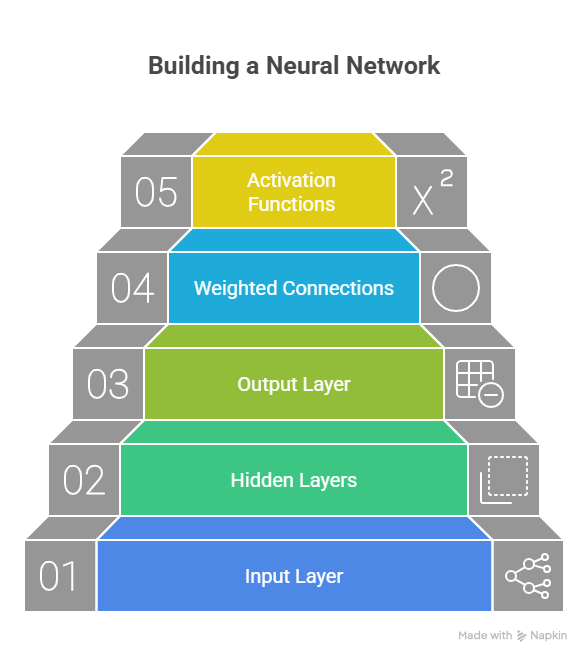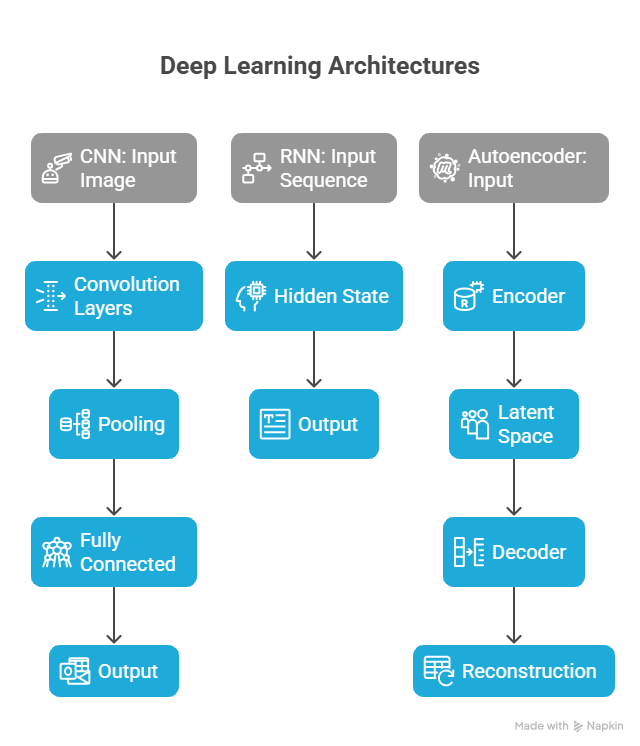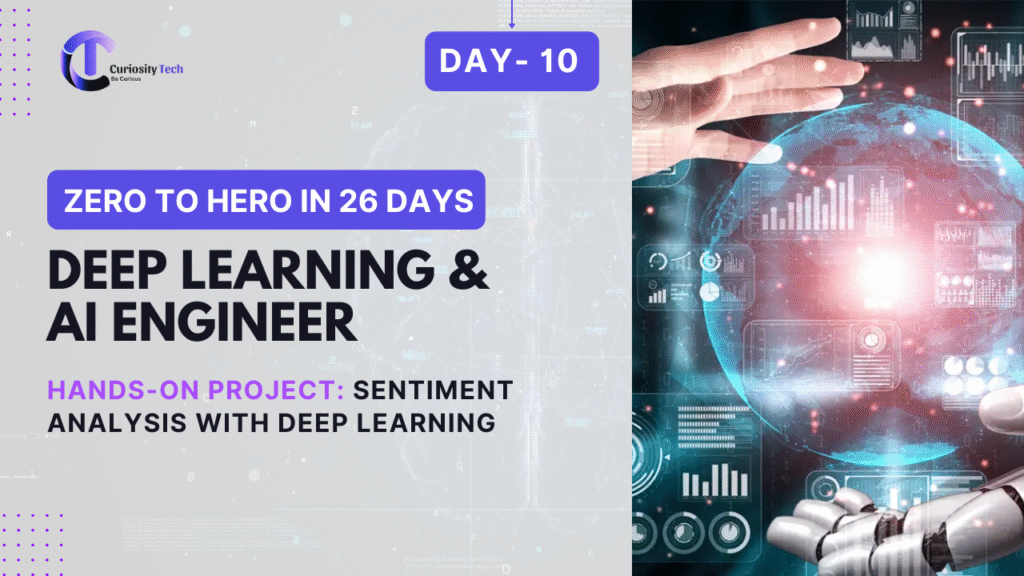Introduction
In 2025, deep learning has become a cornerstone of machine learning, powering AI systems in vision, speech, natural language, and autonomous systems. Unlike traditional ML, deep learning can automatically extract features from raw data, making it ideal for complex datasets.
At curiositytech.in (Nagpur, Wardha Road, Gajanan Nagar), we emphasize that deep learning is not just about algorithms—it’s about understanding architecture, optimization, and practical applications. This blog will take you on a deep, detailed journey into deep learning, suitable for aspiring ML engineers.
1. What is Deep Learning?
Definition: Deep learning is a subset of machine learning that uses artificial neural networks (ANNs) with multiple layers to model complex patterns in data.
Key Features:
- Works well with large datasets
- Learns hierarchical representations
- Reduces the need for manual feature engineering
CuriosityTech Insight: Beginners often confuse ML with deep learning. ML relies on manually engineered features, while deep learning learns features automatically from raw inputs.
2. Neural Network Architecture
Basic Components of a Neural Network:
| Component | Description | Analogy |
| Input Layer | Receives raw features | Sense organs taking input |
| Hidden Layers | Intermediate computation layers | Brain processing |
| Neurons | Units performing calculations | Neurons in human brain |
| Weights & Biases | Parameters learned during training | Strength of neuron connections |
| Activation Function | Introduces non-linearity | Brain firing thresholds |
| Output Layer | Produces predictions | Decision or action |
Visual Architecture Diagram Description:

- At curiositytech.in, students visualize neural networks for small datasets first, understanding how data flows through layers.
3. Activation Functions
Activation functions allow networks to learn complex non-linear patterns.
| Function | Formula | Use Case |
| Sigmoid | σ(x)=11+e−x\sigma(x) = \frac{1}{1+e^{-x}}σ(x)=1+e−x1 | Binary classification |
| Tanh | tanh(x)=ex−e−xex+e−x\tanh(x) = \frac{e^x – e^{-x}}{e^x + e^{-x}}tanh(x)=ex+e−xex−e−x | Centered activation |
| ReLU | f(x)=max(0,x)f(x) = \max(0, x)f(x)=max(0,x) | Hidden layers in deep networks |
| Softmax | σ(zi)=ezi∑jezj\sigma(z_i) = \frac{e^{z_i}}{\sum_j e^{z_j}}σ(zi)=∑jezjezi | Multi-class classification |
4. Training Deep Neural Networks
Key Steps:
- Forward Propagation: Compute output from inputs using weights, biases, and activation functions
- Loss Function: Measures error between predicted and actual output
- Examples: MSE for regression, Cross-Entropy for classification
- Examples: MSE for regression, Cross-Entropy for classification
- Backward Propagation: Compute gradients of loss w.r.t weights and biases using chain rule
- Optimization: Update weights using algorithms like SGD, Adam, RMSprop
Scenario Storytelling:
Riya, a student at CuriosityTech Park, trains a deep network to classify handwritten digits (MNIST dataset). Initially, accuracy is 75%. After applying Adam optimizer and adjusting learning rate, accuracy rises to 97%, demonstrating the impact of training strategies.
5. Deep Learning vs Traditional ML
| Aspect | Traditional ML | Deep Learning |
| Feature Engineering | Manual | Automatic |
| Dataset Size | Small to Medium | Large (thousands to millions) |
| Complexity | Limited patterns | Can model high-dimensional, complex patterns |
| Hardware Requirements | CPU sufficient | GPU/TPU often required |
| Training Time | Short | Long (requires tuning) |
At CuriosityTech.in, students learn both approaches, enabling practical decision-making for real-world projects.
6. Popular Deep Learning Architectures
| Architecture | Description | Use Case |
| Feedforward Neural Network | Standard ANN | Regression & Classification |
| Convolutional Neural Network (CNN) | Handles grid-like data (images) | Image recognition, object detection |
| Recurrent Neural Network (RNN) | Handles sequential data | Text generation, stock prediction |
| LSTM/GRU | Advanced RNNs for long sequences | NLP, time-series forecasting |
| Autoencoders | Unsupervised representation learning | Dimensionality reduction, anomaly detection |
Diagram Description:

7. Real-World Applications
| Field | Application | Deep Learning Architecture |
| Computer Vision | Facial recognition | CNN |
| Natural Language Processing | Chatbots, translation | RNN, LSTM, Transformers |
| Healthcare | Disease diagnosis | CNN, Autoencoders |
| Finance | Fraud detection | Feedforward, LSTM |
| Autonomous Vehicles | Object detection & tracking | CNN, RNN combinations |
Students at CuriosityTech Nagpur often work on hands-on deep learning projects for real datasets, gaining practical deployment skills.
8. Tips to Become a Deep Learning Expert
- Master the fundamentals: Linear algebra, calculus, probability
- Understand architectures deeply: Feedforward, CNN, RNN
- Practice on real datasets: MNIST, CIFAR-10, IMDB reviews
- Experiment with optimizers and learning rates
- Leverage GPUs and cloud platforms: AWS Sagemaker, Google Vertex AI
- Join communities: curiositytech.in provides mentorship, guidance, and peer learning
9. Key Takeaways
- Deep learning automates feature extraction, enabling complex problem solving.
- Understanding architecture, activation functions, and training methods is mandatory for ML engineers.
- Hands-on practice bridges the gap between theory and industrial applications.
As we tell learners at CuriosityTech.in: “Deep learning is not magic—it’s understanding layers, data flow, and optimization in depth.”
Conclusion
Deep learning is the next frontier for ML engineers in 2025, offering unmatched capabilities in image, text, and sequential data analysis. By mastering deep learning:
- You can solve high-dimensional, complex problems
- Build production-ready AI systems
- Advance in cutting-edge domains like computer vision, NLP, and autonomous systems
CuriosityTech.in provides extensive mentorship, practical labs, and real-world projects, preparing learners for top ML careers. Contact +91-9860555369 or contact@curiositytech.in to start your deep learning journey.

